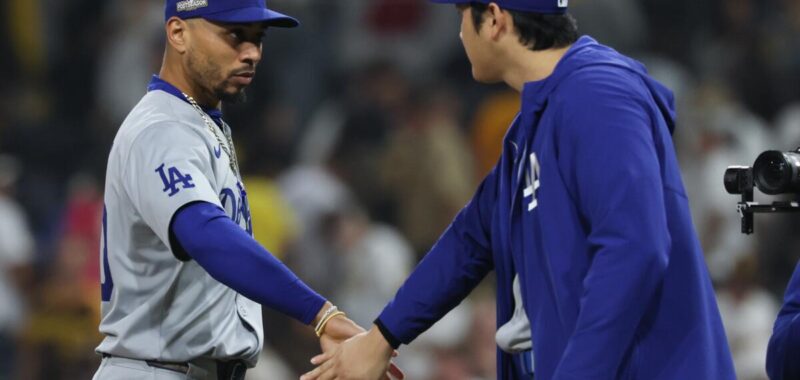
It’s a cyclical thing, and the cycle has come back around to the tired lazy narrative. The teams with the three largest payrolls are three of baseball’s final four. Those three teams play in New York or Los Angeles. Baseball is doomed.
But think back to this time last year. There was a narrative last October too.
Tony Clark, the executive director of the players’ union, stood on the field at Dodger Stadium and smiled. He has heard it all before. Baseball is not doomed.
“Last year,” Clark said, “the conversation was the exact opposite: Everyone was concerned about the format, because the teams that had the most wins over the course of the year didn’t find their way late into the postseason.
“This year, it’s flipped.”
This year, the Dodgers spent the money, earned a first-round bye, and advanced. Last year, the Dodgers spent the money, earned a first-round bye, and did not advance.
So was the system was rigged in favor of the rich teams this year and rigged against the rich teams last year?
Baseball is not doomed because it lacks a salary cap. The Kansas City Chiefs dominate the NFL, but not because the NFL has a salary cap. The Chiefs dominate because they have Patrick Mahomes, who has led his team to three championships in five years, including back-to-back championships.
The last back-to-back champions in Major League Baseball: the New York Yankees, 24 years ago. Sixteen MLB teams have won the World Series since then, including the Angels, Chicago White Sox, Kansas City Royals, Miami Marlins, Texas Rangers and Washington Nationals.
For MLB, competitive balance comes from the expanded postseason, because — stop us if you’ve heard this before — anything can happen in a short series. No team has to spend $300 million to win.
The lowest seed in the National League playoffs represented the league in the World Series the last two years and could for a third consecutive year. Those three teams won 87, 84 and 89 games.
“Look, resources help,” said David Stearns, the Mets’ president of baseball operations. “There is no question about that. Resources provide an advantage. It’s our job to do what we can to turn that into competitive teams.”
That need not involve buying Shohei Ohtani.
Clark bristles at the notion of payroll as destiny, because owners can allocate resources in any number of ways that do not involve buying Juan Soto this winter. No fan base should have to put up with an owner who talks more about market size and less about the World Series.
“Whether it’s the (luxury) tax, whether it’s the draft, whether it’s international signings or any number of things in between — indifferent to the market you are in — you can be the last team standing if you are committed to being the last team standing,” Clark said.
The Mets set an MLB payroll record last season and finished with a losing record. Owner Steve Cohen hired Stearns from the Milwaukee Brewers for the same reason Dodgers owner Mark Walter hired Andrew Friedman from the Tampa Bay Rays a decade ago: If you can apply the lessons of winning consistently with little money to a team with lots of money, well, that can be Moneyball fit for a parade rather than a Brad Pitt movie.
“The Dodgers have done that,” Stearns said. “I think copying any exact model of another team is probably a fool’s errand. We need to be able to do it in our own way.”
Friedman had to find his own way too. In his time with the Rays, he won in part because the New York Yankees and Boston Red Sox lavished ultimately burdensome large contracts upon players deep into their 30s.
With the Dodgers, Friedman focused on paying down those kinds of contracts, or waiting them out. In his first five years, he did not sign a player for more than $100 million.
Since then, in order: Mookie Betts (12 years, $365 million, playing through age 39); Freddie Freeman (six years, $162 million, through age 38); Ohtani (10 years, $700 million, through age 39) and Yoshinobu Yamamoto (12 years, $325 million, through age 37).
“We’ve been very selective about the guys to which we have committed long-term contracts,” Friedman said. “It’s why, for the most part, I have shied away from it with guys that haven’t been here, that we don’t have first-hand knowledge of how they prepare, how they compete, what they do to get ready, how competitive they are, what kind of teammate they are.
“There are things we dig on and try to understand as best we can. But it never replaces first hand. With Mookie, we had some coaches that had been with him early in his career and had enough that we felt good about it. Freddie, we felt like we knew enough, and Shohei as well.
“That’s been a limitation for us. We are probably not as aggressive as some other teams, on guys where there’s a lot more unknowns for us.”
In fairness, no one in, say, Minnesota wants to hear Friedman talk about limitations. But each team should be able to define its limitations and surmount them well enough to assemble a playoff team, if not a championship team, in a league in which 40% of teams make the playoffs.
Nevertheless, as the Dodgers and Mets continue their NLCS clash, Stearns understands that fans of other teams might skip the nuance of understanding how he defines his limitations and skip directly to the aggravation of competing against a team with a $300-million payroll.
“If we’re winning enough to aggravate people,” Stearns said with a laugh, “that’s a good thing.”

